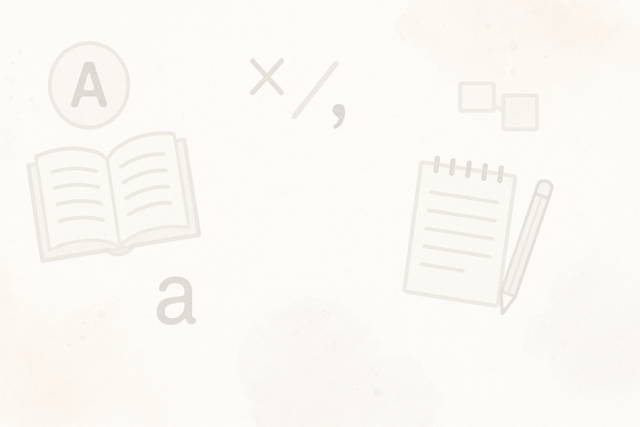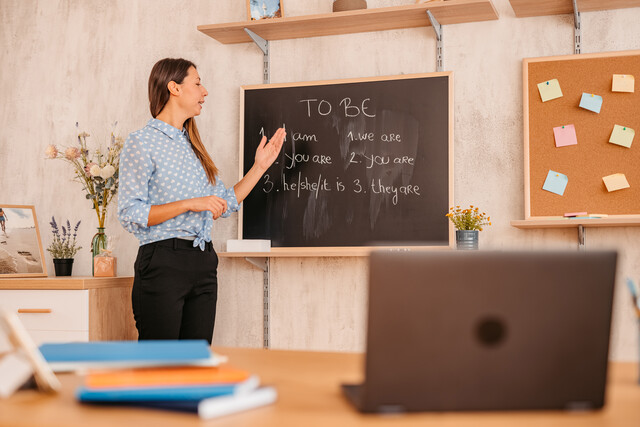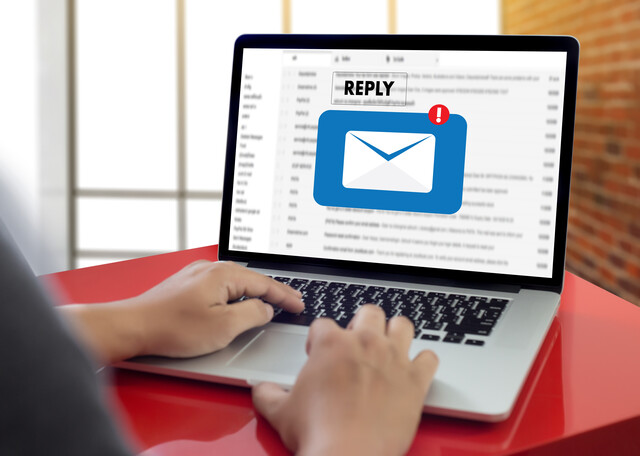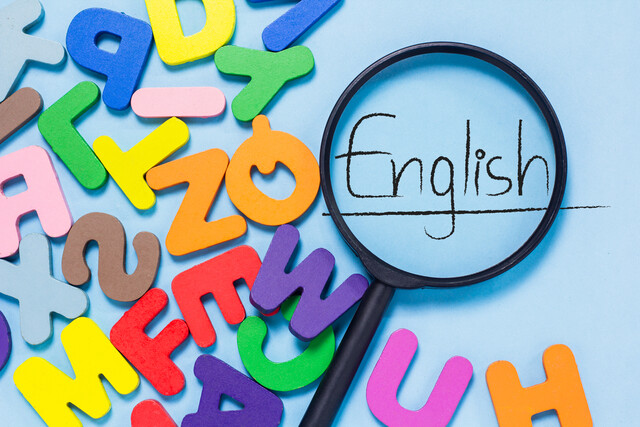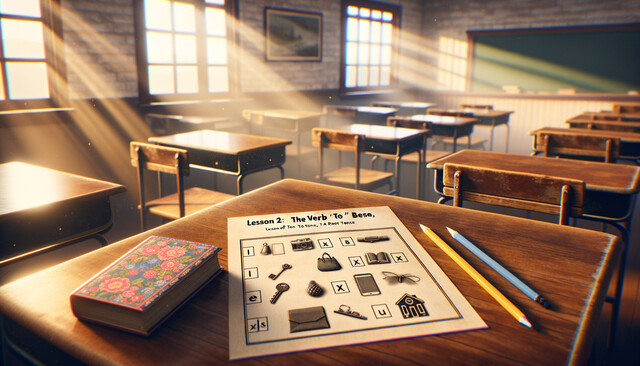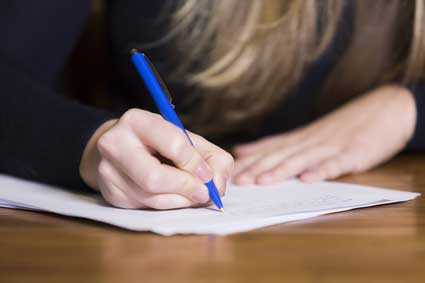Native speakers of English totally take for granted the use of "a," "an" and "the." It seems so simple, right? Surely this is an easy class to teach.
Unfortunately that is not true.
The problems students have with A, An &The
Some languages (including Slavic languages like Russian) have no real equivalent for these articles. You might hear non-native speakers who just abandon the words altogether, never attempting to use them, gleefully running through sentences and saying things like "I went to movie yesterday. It was not good movie."
Even some more advanced students make these kinds of mistakes and often theses bad speaking habits have become entrenched, especially since in fact what they say is generally understandable without using articles.
Despite the fact that they are successfully communicating, they are speaking broken English, to their disadvantage. No student, and especially not students who are learning English in order to advance in their profession, wants to be speaking broken English.
So it's both a challenge and a responsibility for you as a teacher to get your students to use their articles in the right way.
But teaching it can be tough, since native speakers use articles intuitively, never having to think about the rules, which turn out to be rather complicated.
On top of the basic rules of usage, students also have to learn whether to use "a" or "an."
If you're lucky, your students will be from a language background (for example, a Romance language like French or Spanish) that includes articles.
No matter what, the good news is that with plenty of good instruction, modeling and practice, students will start to get it. But with many students, it doesn't happen all at once; it's a process that can take place over many classroom lessons.
Even before a class on articles, you will have already introduced the idea every time you write a noun on the board.
That's why we always write "a dog" or "an office worker" on the board when presenting these nouns, or for uncountable nouns, either just "water" and "information" or "some water" and "some information."
An introduction to the articles a, an & the
Your first task as an ESL teacher is to make sure that you understand the rules about why and when we use (or don't use) articles in various sentences. You will have to approach the subject from the point of view of an outsider to the language, and see how the whole thing works, so you can lead your students to their own understanding.
Think about it. Why so we say "The dogs are in the house" but then say "Dogs are good pets," without "the"? Most native speakers have to stop and think about that one. Imagine how it is for a student learning English!
Here is a table that gives a simple explanation of how we use "a/an" and "the." It can also be used in class:
(Articles) A, An, The
general specific
singular (1) A / AN THE
It is a dog. I like the dog. The dog is nice.
It is an umbrella. The umbrellas are red. I like the red umbrellas.
plural (2+) --- THE
I like umbrellas. I like the umbrellas in the photos.
I want money. I gave the money to the children.
But students need more than just this table. A good class on articles will present several ways of understanding the subject. It helps to also list the usage this way:
A
-used before a consonant sound.
a tree, a university, a house
AN
-used before a vowel sound
an eraser, an envelope, an hour, an umbrella
A / AN
-used with singular nouns.
a laptop, a movie, a television.
-used with a person, place, thing that is NOT SPECIFIC.
I want to buy a computer. (NOT A SPECIFIC COMPUTER!)
I need an umbrella. (NOT A SPECIFIC UMBRELLA)
-used with jobs
I am a teacher. I am an English teacher.
She is a pilot. He is a waiter.
Mary is an office worker.
THE
-used with singular or plural nouns that are SPECIFIC:
I want the computer on the table.
I see the trees and the houses.
-used with
a person, place, thing, that is SPECIFIC or
persons, places or things that are SPECIFIC:
I want to buy the new Macintosh computer. (A SPECIFIC COMPUTER!)
I go to the fitness center every day. (A SPECIFIC fitness center)
The umbrella is on the desk. (A SPECIFIC umbrella.)
A thorough overview will also include:
The second mention of a noun. For example:
I saw a man. The man was very tall.
THE:
-geographical points in the globe: the North Pole, the Equator
-rivers, oceans and seas: the Nile, the Pacific Ocean, the English Channel
- "The" is NOT used with countries EXCEPT for those that contain: states, kingdom, republic, union and "united":
-Mexico, China, North Korea
-The United States, The United Kingdom, The Irish Republic
"A / An" is NOT used with uncountable nouns:
-I want water. The water is cold.
-Information is power. The information is in the document.
No article is used for sports:
-I like football. I play tennis.
Beginner classes will usually focus on the basics of "A / An" and "The.
Using grammar terms in the classroom
Before we start with the lesson plan, notice how "Articles" is written at the beginning of the first chart above, and the word is used a few times in the explanations.
In a class that is not ESL, for example an advanced English class in high school, such terms are used as part of regular academic instruction. There might be a classroom lesson on "The Decline of the Subjunctive."
In an ESL classroom, we mention the grammar terms as needed but we don't use them constantly during the class.
That's because students who are learning communicative English don't really need to know terms such as "past perfect" or "demonstrative pronouns" for their daily life; they won't use these terms when going doing business, speaking with friends, etc.
In this case it's especially true that you don't want to confuse students with the term unnecessarily, since "an article" is a more commonly-used word for texts in a newspaper or magazine, and that is the meaning that learners will need in their daily life.
But it doesn't hurt for them to be exposed to such terms; some students might want to say, for example, "I need more help with phrasal verbs." That's why we do include them in our boardwork and we might have to use them during explanations.
Lesson Plan
Level: Intermediate
Classroom Objectives:
Text Comprehension: Understanding how to use "a/an, the"
To be able to use "a/an, the" when talking about food.
Vocabulary: fitness center, scissors, umbrella
Notice this lesson plan is designed for intermediate students who already know the past simle tense, etc.
Presentation
A good option for presenting this aspect of grammar is to first present the table on the board, emphasizing the "a" or "an" or "the" as you write it. Emphasize and repeat with the class a few times.
general specific
singular (1) A / AN THE
It is a dog. I like the dog. The dog is nice.
It is an umbrella. The umbrellas are red. I like the red umbrellas.
plural (2+) --- THE
I like umbrellas. I like the umbrellas in the photos.
I want money. I gave the money to the children.
Then present this overview. This could be a handout, since it is a lot of info.
Otherwise, as you write on the board or read the handout, emphasize the "t" in "tree" (etc.) to show when "a" is used. Use "Youtube" and then "university" to emphasize that they have the same consonant sound at the beginning requiring "a":
A
-used before a consonant sound:
a tree, a Youtube channel, a university, a house
In this part, emphasize the vowel-sound beginnings of the nouns, especially "hour." If you're not writing on the board yet, write it, and after you say "hour," hold your hand over the "h" to show it is silent and that is why "an" is used with it:
AN
-used before a vowel sound: an umbrella, an apple, an hour
Before writing this next part, circle the above and draw an arrow to the next part, to show that the two above lines are one category that will now be presented. If you're using a handout, you could have the student circle them:
A / AN
-used with singular nouns:
a movie, a television, an apple, an umbrella
-used with a person, place, thing that is not specific.
I want to buy a computer. I don't care about the brand or the size or anything.
I need an umbrella. Color, size, doesn't matter.
I need a fitness center.
-used with jobs
I am a teacher. I am an English teacher.
She is a pilot. He is a waiter.
Mary is an office worker.
THE
-used with singular or plural nouns that are specific:
I want the computer on the table.
I see the trees and the houses in the photos.
Where are the scissors?
-used with
a person, place, thing, that is specific or
persons, places or things that are specific:
I want to buy the new Sony computer. (Specifically the new Sony computer.)
I go to the fitness center every day. (Specifically the special fitness center)
The umbrella is on the desk. (The specific umbrella.)
After this, go through of the other common uses:
The North Pole, The Equator, The Nile, The Pacific Ocean, The English Channel
The United States, The United Kingdom, The Irish Republic
The best, the worst, the biggest, the most expensive
Uncountable nouns:
I want water. The water in the swimming pool is cold.
Information is power. The information you want is here.
For this last part, list the sentences, then point out to the space in front of the words for sports and point out there is "nothing" in front:
Sports:
I like football. I play tennis.
Practice 1
Pass out the handout. Then hold up the handout and say "Listen and write 'a,' 'an,' 'the,' or a line for nothing. Example."
Write on the board:
I bought ______ car. __________ is really nice.
Now read the first line in the example and include the article: "I bought a car. The car is really nice." Repeat twice. Then fill in the blanks on the board.
I bought a car. __The_____ is really nice.
Point to the example on your handout and say "write 'a' and write 'the.'" Quickly go around the class and see that everyone has filled in the blanks in their example.
Do the same for the second line of the example. Write:
On Saturday I play ________ tennis.
Say "On Saturday I play tennis." Repeat. Go to the board and draw a line in the blank:
On Saturday I play __-------__ tennis
Say "draw a line for nothing." Again check the students have completed the example.
Again say "Listen and write 'a,' 'an,' 'the,' or a line for nothing" while you indicate the handout.
Here is the handout:
Listen and fill in the blanks with a / an / the or ----
Example:
I bought ______ car. __________ is really nice.
On Saturday I play ________ tennis.
Mary and John are at a fast-food restaurant.
John: What's good here?
Mary: ________ hamburgers are good, and ________pies are good.
John. I have _______ problem. I don't have ___ money.
Mary: Where is ______ money I gave you yesterday?
John: I spent ________ money!
Mary: What did you buy?
John: I bought ________ coat and ________ hat. ________ coat is blue and ________ hat is black. So I don't have ________ money.
Mary Okay, I will pay for ________ food. I'm not hungry.
---
Waiter: What would you like?
John: I want ________ hamburger, ________ apple pie and ________ soda.
---
Mary: How is ________ food? Do you like it?
John: ________ hamburger and ________ soda are good. But I don't like ________ apple pie. ________ pie is too sweet.
Mary: Yes, ________ pies are really sweet here.
Here is what you read:
Mary and John are at a fast-food restaurant.
John: What's good here?
Mary: The hamburgers are good, and the pies are good.
John. I have a problem. I don't have ___ money.
Mary: Where is the money I gave you yesterday?
John: I spent the money!
Mary: What did you buy?
John: I bought a coat and a hat. The coat is blue and the hat is black.
So I don't have the money.
Mary Okay, I will pay for the food. I'm not hungry.
---
Waiter: What would you like?
John: I want a hamburger, an apple pie and a soda.
---
Mary: How is the food? Do you like it?
John: The hamburger and the soda are good. But I don't like the apple pie. The pie is too sweet.
Mary: Yes, the pies are really sweet here.
After the first reading, say "Okay? Again." Read it aloud again. Quickly check the answers by reading it a third time, and pausing at each blank, having the class say the answer aloud. Confirm every right answer by repeating it.
If there is a problem when the students answer, go to the chart on the board or the category why "the" (for example) is the right answer.
Practice 2
Hand out the next exercise. It is in two parts; do each part separately. Point out the first part is only with "a" and "an" and the second with a / an / the / -----. Go around the class and if students need help, again use the board to show to indicate the right answer.
Practice 1: Articles
Fill in the blanks with a / an
Example:
_____ dog
a dog
1. _______ desk
2. _______ hour
3. _______ computer
4. _______ umbrella
5. _______ house
6. _______ university
Fill in the blanks with a / an / the / -----
1. _______ books are on _______ table.
2. _______ pens are in _______ desk.
3. Maria is _______ pilot.
4. John is _______ student.
5. _______ scissors on the table are sharp.
6. _______ dog is _______ good friend.
7. I visited _______United States.
8. I saw _________ movie yesterday. _________ movie was good.
9. I bought ____________ car. __________ car is red.
10. I play ________ football. I don't play _________ basketball.
11. Star Wars is ____________ best movie.
At the end, have the students read each line from the exercise one at a time, calling them out at random.
Production
Put them into closed pairs and have them read the dialogue, each one taking turns being John and Mary.
Now hand out this exercise. Point to the examples and model the question and the form the answer must take. Call on some students to answer the questions. You can also do some of the actual exercises themselves with students until it's clear that they should answer with two sentences, first with "a" and then "the."
For example, call on a student and ask "Do you have a cat or a dog." Make sure the answer goes (for example) "Yes I have a dog. The dog is black" or "The dog is named." etc.
Then have them ask and answer the questions in their pairs.
Ask and answer the questions.
Answer with two sentences, first with "a" and then "the."
Example:
Q. What did you eat for dinner yesterday?
A. I ate a hamburger. The hamburger was terrible!
Q. Do you play sports?
A. Yes, I play baseball. Baseball is fun.
1. What did you buy this week?
2. Did you see a movie recently?
3. Do you play sports?
4. What did you eat for breakfast this morning?
5. Did you watch a TV show recently?
6. What did you eat for dinner yesterday?
7. Do you have a smartphone?
8. Do you have a computer?
9. Did you go to a restaurant recently?
10. Did you drink a beer recently?
11. Did you eat a sandwich recently?
12. Do you have a dog or a cat?
13. Do you have a friend who lives far away? Where is the friend?
14. Do you have an idea for a movie?
15. Do you live in a house or an apartment?
16. Do you have a car?








